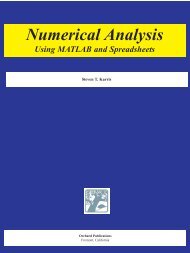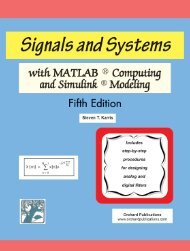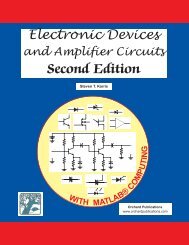endof-
Signals & Systems Front Cover FOURTH.qxp - Orchard Publications
Signals & Systems Front Cover FOURTH.qxp - Orchard Publications
Create successful ePaper yourself
Turn your PDF publications into a flip-book with our unique Google optimized e-Paper software.
Chapter 2The Laplace TransformationThis chapter begins with an introduction to the Laplace transformation, definitions, andproperties of the Laplace transformation. The initial value and final value theorems are alsodiscussed and proved. It continues with the derivation of the Laplace transform of commonfunctions of time, and concludes with the derivation of the Laplace transforms of common waveforms.2.1 Definition of the Laplace TransformationThe two−sided or bilateral Laplace Transform pair is defined asL { ft ()} = Fs ( ) = ft () e – st dt∫∞–∞(2.1)L 1– { Fs ( )} = ft ()=σ + jω-------1Fs ( )2πj∫e st dsσ – jω(2.2)where L{ ft ()} denotes the Laplace transform of the time function ft (), L – 1 { Fs ( )}denotes theInverse Laplace transform, and s is a complex variable whose real part is σ , and imaginary partω , that is, s = σ + jω .In most problems, we are concerned with values of time t greater than some reference time, sayt = t 0 = 0 , and since the initial conditions are generally known, the two−sided Laplace transformpair of (2.1) and (2.2) simplifies to the unilateral or one−sided Laplace transform defined as∫L { ft ()} = F( s) = ft () e – st dt = f()t e – st dtL 1t 0∞– σ + jω1{ Fs ( )} = f()t = ------- Fs ( )2πj∫e st dsσ – jω∫∞0(2.3)(2.4)The Laplace Transform of (2.3) has meaning only if the integral converges (reaches a limit), thatis, ifSignals and Systems with MATLAB ® Computing and Simulink ® Modeling, Fourth EditionCopyright © Orchard Publications2−1







